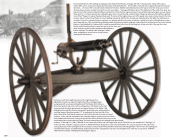Page 152 - 4094-BOOK2
P. 152
Features a notch front sight mounted on the right ahead of an
adjustable V-notch rear sight. The right side of the cartridge hopper
is engraved with an arrow pointing forward. This Model 1895 utilizes a
Bruce feed system and comes with one magazine. It still retains some of it’s
correct period olive drab green paint (an original feature of the Model 1895
Gatling!) underneath the breech casing and in protected areas underneath the
cartridge hopper. Matching number “10” is marked on the front top flat of the
frame, behind the front barrel retainer on top of all the barrels, front and rear barrel
retainers, on the outside and inside of the cartridge hopper, ejector, top rear of all the
bolts, underneath the breech casing, on the left rear surface of the breech cover, on the
crank locking piece, and on the bolt plug. The black painted barrels are marked at the breech with
numbers “1” through “10”, “R.A.C.” (Rinaldo A. Carr) inspection initials, and “V/P/eagle head” proofs. The bolts are also numbered “1” through “10”
on the top front. Includes a separate caisson on Archibald wheels designed to carry extra ammunition. The caisson attaches to the yoke of the
carriage by means of the towing hook. Also includes a resin portrait of Theodore Roosevelt titled “The Rough Rider” (14.5”x17.5”). The Gatling Gun
revolutionized warfare, and with Gatling’s engineering invention changed the way wars were fought forever; with the successful use of Model
1895s like this example solidifying the Gatling gun’s legacy.
In the included book, “The Gatlings at Santiago,” John Parker himself states on pages 259-260, “I was placed in charge of four guns,
model 1895, cal. 30, and at once began the instruction of the detachment… On June 6th, I took my men and guns aboard the transport
Cherokee… On June 25th I received verbal instruction from Gen. Shafter to disembark at once [for Cuba], select the necessary number
of mules (two per gun), and get to the front as soon as possible…” On page 269 Parker states, “The efficiency of the work of my guns was
attested to me by numerous Spanish officers and prisoners. Their favorite expression was: ‘It was terrible when your guns opened, always.
They went b-r-r-r-r, like a lawn mower cutting the grass over our trenches. We could not stick a finger up when you fired without getting
it cut off-so!’” Pages 6-7 quotes Theodore Roosevelt, “If a troop of my regiment was sent off to guard some road or some break in the lines,
we were almost certain to get Parker to send a Gatling along, and, whether the change was made by day or by night, the Gatling went...
certainly, if I were to command either a regiment or a brigade, whether of cavalry or infantry, I would try to get a Gatling battery-under a
good man-with me. I feel sure that the greatest possible assistance would be rendered, under almost all circumstances, by such a Gatling
battery, if well handled; for I believe that it could be pushed fairly to the front of the firing-line. At any rate, this is the way that Lieut.
Parker used his battery when he went into action at San Juan, and
when he kept it in the trenches beside the Rough Riders
before Santiago.” This Model 1895 example is of the
same configuration as the four in use by Parker’s
Gatling Gun Detachment.
150


